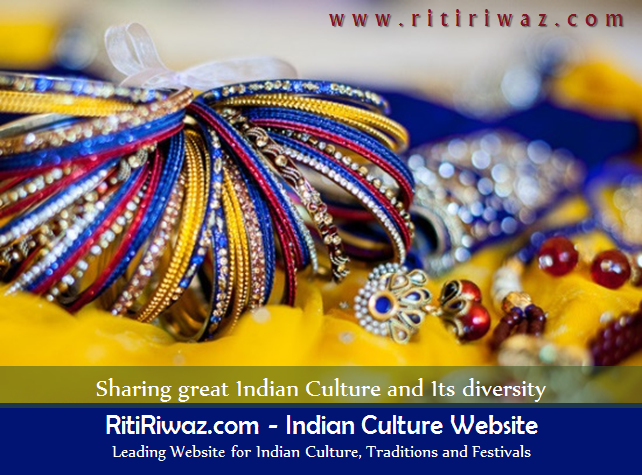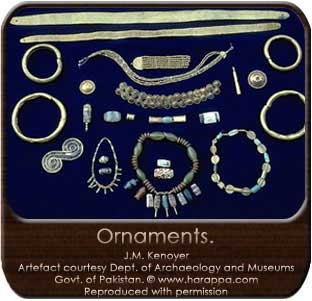History Of Indian Jewelry

The historical background of Indian jewelry takes us back to the history of the country itself as both are almost equally old. The history can be dated back to 5000 years ago to the pre-historic past when the curiosity to beautify themselves by adorning some jewelry pieces arouse in people. Since the beginning of the journey, the charm of jewelry and the beauty of Indian women by adorning it never separated.
In India, jewelry does not only have traditional and aesthetic value but is also considered a source of security in times of financial crisis. The amount of jewelry owned by a woman also signifies her status and adds to the riches in her name. Jewelry has covered its journey since the beginning as an evolving art form. The beauty of Indian jewelry lies in the uniqueness of its design and the efforts of the workmanship involved in creating intricate designs.
Origin and history of Indian Jewelry
Indian jewelry history was referred to as the gemstones used in the crown of kings. Primitive men and women used flora and fauna around themselves to decorate themselves. They used seeds, flowers, feathers, and beads carved out of wood, stone, and bone as jewelry. Even shells, berries, wings of butterflies, and beetles were used as jewelry. With the advancement of civilization the material was changed to copper, ivory, agate, and semi-precious stones and later to silver, gold, and precious stones.
Accurate dating the history of Indian jewelry is difficult since the styles and designs continue to change over time. We have found sculpted images of Gods, Kings, men, and women which adorn the corridors of ancient temples provide a three-dimensional record of prehistoric styles and crafting techniques.

During the Indus valley civilization, they used techniques of Melting, refining, molding, chiseling, the setting of stones, designing, casting, filling color, glazing the stone, and making facets. The common ornaments used were Bracelets, necklaces, bangles, ear ornaments, rings, head ornaments, brooches, and girdles.
During the Gandhara period, Greek and Hellenistic styles were used. In the Sunga period precious stones like rubies, corals and sapphires were used. From 1st to 16th-century Engraving, granulation, and filigree work. Used dyes and molds to form the structure of the jewel. Fine decorative designs, inlaying of precious stones and cutting of precious stones in different shapes and designs and Portugal style was used in the 16th century.
In the Mughal period Iranian and Hindu styles, Kundan and Meenakari(enameling) work were very popular. With the came of Britishers there was British style and open-claw setting techniques used to make jewelry.
Gold always had an aesthetic appeal and its beauty recommends it for ornament making above all other metals. Since the Stone Age, people are making jewelry of gold. Pure gold is designated as 24 karats but because of its softness, it is usually mixed with the base metal to make jewelry and to provide hardness, ductility, melting, color, and other properties.
In India 22 karat is most desired, which has 91.6 percent of gold. Alloys are formed with different metals such as silver, copper, nickel, and platinum. The varying proportion of these metals leads to different purities of gold. Copper is a commonly used base metal, yielding a color that remains as close as possible to that of pure gold.
While making jewelry gemstones, coins, and other precious items are used. Platinum alloys and silver is used in making jewelry, while stainless steel findings are sometimes used in making costume jewelry.

Beads are commonly used in jewelry which is made of glass, gemstones, metal, wood, shells, clay, and polymer clay. The story of Indian jewelry is incomplete without a mention of the two most famous gems in the world – the Kohinoor and the Hope Diamond.
Kohinoor is a priceless diamond the size of a ping pong ball that was found in Guntur, in Andhra Pradesh, and currently housed in the Tower of London in the United Kingdom.
Hope Diamond is a lustrous blue gem rumored to be a cursed stone that brings ill luck to its owner. The stone was discovered in India and is believed to have been plucked from a sculpted statue of a goddess in a temple and is currently housed with the National Gem and Mineral Collection at the National Museum of Natural History in Washington.
The range of jewelry in India varies from religious to purely aesthetic types. It is crafted not only for humans but also for the Gods, ceremonial elephants, and horses. Regional differences can be observed in the making of jewelry, depending on the differences in geography, people, culture, and lifestyle.
While the designs in solid gold jewelry of Tamil Nadu and Kerala are inspired by nature, the Meenakari and Kundan styles of jewelry making have been influenced by the Mughal dynasty. Then there is a huge range of silver beads found all over India, especially in Rajasthan, Gujarat, Madhya Pradesh, and Himachal Pradesh. Their availability leads to the development of bead jewelry, popular to date.
While Assamese jewelry is influenced by local flora and fauna, Manipuri jewelry-makers make use of items like shells, animal claws, teeth, and precious and semi-precious stones. These huge varieties of ornaments bear testimony to the excellent skill of the jewelers and craftspeople of the country. Indian jewelry in Gold, diamonds, silver, sterling silver, precious stones, copper, and semi-precious stones is a rage all over the world.
Suggested Read: Significance of Indian Jewellery
